
Seyfert galaxies are one of the two largest groups of active galaxies, along with quasars. They have quasar-like nuclei with very high surface brightnesses whose spectra reveal strong, high-ionisation emission lines, but unlike quasars, their host galaxies are clearly detectable.

NGC 404 is a field galaxy located about 10 million light years away in the constellation Andromeda. It was discovered by William Herschel in 1784, and is visible through small telescopes. NGC 404 lies just beyond the Local Group and does not appear gravitationally bound to it. It is located within 7 arc-minutes of second magnitude star Mirach, making it a difficult target to observe or photograph and granting it the nickname "Mirach's Ghost".
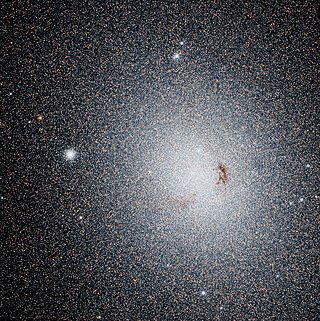
NGC 185 is a dwarf spheroidal galaxy located 2.08 million light-years from Earth, appearing in the constellation Cassiopeia. It is a member of the Local Group, and is a satellite of the Andromeda Galaxy (M31). NGC 185 was discovered by William Herschel on November 30, 1787, and he cataloged it "H II.707". John Herschel observed the object again in 1833 when he cataloged it as "h 35", and then in 1864 when he cataloged it as "GC 90" within his General Catalogue of Nebulae and Clusters. NGC 185 was first photographed between 1898 and 1900 by James Edward Keeler with the Crossley Reflector of Lick Observatory. Unlike most dwarf elliptical galaxies, NGC 185 contains young stellar clusters, and star formation proceeded at a low rate until the recent past. NGC 185 has an active galactic nucleus (AGN) and is usually classified as a type 2 Seyfert galaxy, though its status as a Seyfert is questioned. It is possibly the closest Seyfert galaxy to Earth, and is the only known Seyfert in the Local Group.

NGC 2787 is a barred lenticular galaxy approximately 24 million light-years away in the northern constellation of Ursa Major. It was discovered on December 3, 1788 by German-born astronomer William Herschel. J. L. E. Dreyer described it as, "bright, pretty large, a little extended 90°, much brighter middle, mottled but not resolved, very small (faint) star involved to the southeast". The visible galaxy has an angular size of 2.5 × 1.5 arcminutes or 3.24 × 1.81 arcminutes and an apparent visual magnitude of 11.8.

NGC 3227 is an intermediate spiral galaxy that is interacting with the dwarf elliptical galaxy NGC 3226. The two galaxies are one of several examples of a spiral with a dwarf elliptical companion that are listed in the Atlas of Peculiar Galaxies. Both galaxies may be found in the constellation Leo. It is a member of the NGC 3227 Group of galaxies, which is a member of the Leo II Groups, a series of galaxies and galaxy clusters strung out from the right edge of the Virgo Supercluster.

NGC 5548 is a Type I Seyfert galaxy with a bright, active nucleus. This activity is caused by matter flowing onto a 65 million solar mass (M☉) supermassive black hole at the core. Morphologically, this is an unbarred lenticular galaxy with tightly-wound spiral arms, while shell and tidal tail features suggest that it has undergone a cosmologically-recent merger or interaction event. NGC 5548 is approximately 245 million light years away and appears in the constellation Boötes. The apparent visual magnitude of NGC 5548 is approximately 13.3 in the V band.
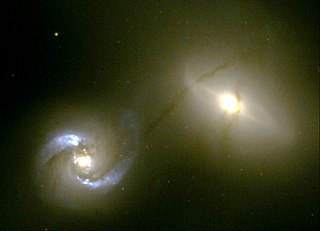
NGC 1409 is a quiescent lenticular galaxy in the equatorial constellation of Taurus. It was discovered by the German-born astronomer William Herschel on January 6, 1785. NGC 1409 is located in close proximity to the smaller Seyfert galaxy NGC 1410, and the two are strongly interacting. Their respective nuclei have a separation of just 23 kly, and they share a diffuse stellar envelope with a radius extending out to 49 kly.

NGC 4138 is the New General Catalogue identifier for a lenticular galaxy in the northern constellation of Canes Venatici. Located around 52 million light years from Earth, it spans some 2.1 × 1.3 arc minutes and has an apparent visual magnitude of 11.3. The morphological classification of NGC 4138 is SA0+(r), indicating it lacks a bar formation and has tightly wound spiral arms with a ring-like structure around the nucleus. It has no nearby companion galaxies.

NGC 4203 is the New General Catalogue identifier for a lenticular galaxy in the northern constellation of Coma Berenices. It was discovered on March 20, 1787 by English astronomer William Herschel, and is situated 5.5° to the northwest of the 4th magnitude star Gamma Comae Berenices and can be viewed with a small telescope. The morphological classification of NGC 4203 is SAB0−, indicating that it has a lenticular form with tightly wound spiral arms and a weak bar structure at the nucleus.
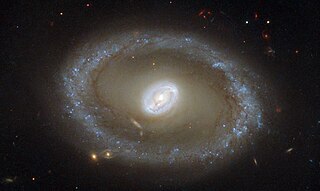
NGC 3081 is a barred lenticular ring galaxy in the constellation of Hydra. NGC 3081 is located about 85 million light-years away from Earth, which means, given its apparent dimensions, that NGC 3081 is approximately 60,000 light-years across. It is a type II Seyfert galaxy, characterised by its bright nucleus. It was discovered by William Herschel on 21 December 1786.

NGC 7469 is an intermediate spiral galaxy in the constellation of Pegasus. NGC 7469 is located about 200 million light-years away from Earth, which means, given its apparent dimensions, that NGC 7469 is approximately 90,000 light-years across. It was discovered by William Herschel on November 12, 1784.

NGC 3367 is a barred spiral galaxy located in the constellation Leo. It is located at a distance of about 120 million light years from Earth, which, given its apparent dimensions, means that NGC 3367 is about 85,000 light years across. It was discovered by William Herschel on March 19, 1784.
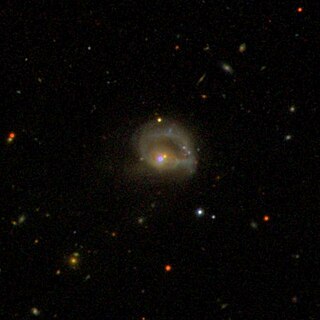
NGC 985 is a ring galaxy in the constellation of Cetus. It is located about 550 million light years away from Earth, which means, given its apparent dimensions, that NGC 985 is approximately 160,000 light years across. It was discovered by Francis Leavenworth in 1886. It is a type 1 Seyfert galaxy.

NGC 3489 is a lenticular galaxy located in the constellation Leo. It is located at a distance of circa 30 million light years from Earth, which, given its apparent dimensions, means that NGC 3489 is about 30,000 light years across. It was discovered by William Herschel on April 8, 1784. NGC 3489 is a member of the Leo Group.

NGC 1386 is a spiral galaxy located in the constellation Eridanus. It is located at a distance of circa 53 million light years from Earth, which, given its apparent dimensions, means that NGC 1386 is about 50,000 light years across. It is a Seyfert galaxy, the only one in Fornax Cluster.

NGC 5363 is a lenticular galaxy located in the constellation Virgo. It is located at a distance of circa 65 million light years from Earth, which, given its apparent dimensions, means that NGC 5363 is about 100,000 light years across. It was discovered by William Herschel on January 19, 1784. It is a member of the NGC 5364 Group of galaxies, itself one of the Virgo III Groups strung out to the east of the Virgo Supercluster of galaxies.
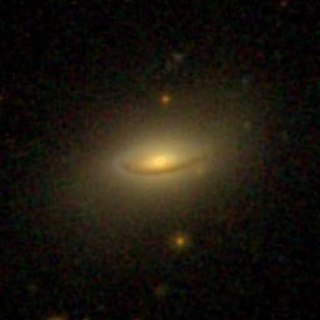
NGC 4074 is a peculiar lenticular galaxy located 310 million light-years away in the constellation Coma Berenices. It was discovered by astronomer William Herschel on April 27, 1785 and is a member of the NGC 4065 Group.

NGC 2273 is a barred spiral galaxy located in the constellation Lynx. It is located at a distance of circa 95 million light years from Earth, which, given its apparent dimensions, means that NGC 2273 is about 100,000 light years across. It was discovered by Nils Dunér on September 15, 1867.
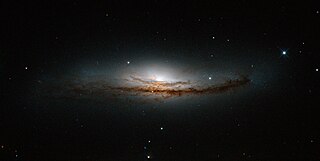
NGC 5793 is an active spiral galaxy located approximately 150 million light years away in the constellation Libra. It is classified as a Type 2 Seyfert galaxy and was discovered by Francis Leavenworth in 1886. The galactic plane is inclined at an angle of 73°, giving it an oval, nearly edge-on appearance with the major axis aligned along a position angle of 150°.
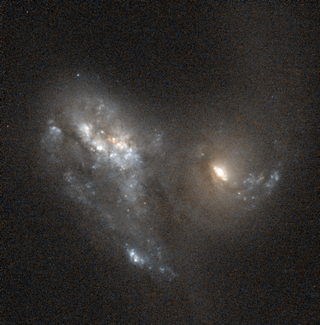
NGC 7592 is an interacting galaxy system located 300 million light years away in the constellation Aquarius. It was discovered by William Herschel on September 20, 1784. The total infrared luminosity is 1011.33 L☉, and thus it is categorised as a luminous infrared galaxy. One of the galaxies hosts a type 2 Seyfert nucleus.




















